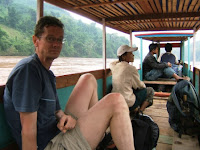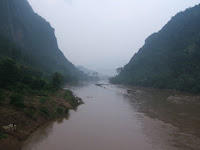The village
of Ban Sam Yord
The scene quickly changed into a scene of huts scattered on
the hill side with chickens, ducks, pigs, cows and goats wandering around.
There was a lot noisy activity taking place in the centre of the village,
coming mainly from the men folk who were constructing a small building in which
to store rice. They were using machetes, crude saws and a hammer and
nails; as we say in the north of England
The Tourist Department constructed the hut we stayed in especially
for visits like ours. It was quite spacious with a room for sleeping and
a kitchen. The floor was hard packed dirt but it was cool and cosy.
After claiming a sleeping place on the raised platform that was the bed,
we ventured round the village to see what was going on.
We called in a home
where four generations lived; the eldest was grandma at a good 78 years old. We
saw children playing a game with spinning tops and watched the animals living
cheek by jowl.
By the time we arrived at the rice store, the men had stopped and were
viewing us quizzically. They were smoking from a water pipe and Mark and
Til could not resist having a go. By their reaction and their antics for
the next thirty minutes, there was no doubt that the smoking mixture was a bit
whacky.
Our guide, Somphone, asked what we would like for evening meal.
We had a choice of goat, duck, chicken or pork. We settled for pork
and Somphone promptly identified a succulent specimen in the yard. A man
from the house next door caught it and trussed it up. It was small, but it could kick and squeal
like an animal ten times its size. First, the front legs were tied
together, then the back legs and a small log passed from front to back. It made enough noise but was bound in such a
way it could not move. Just outside the hut was a water well, which was
the main supply for drinking, washing and cooking. There was also a square frame, and the log,
complete with trussed pig, was placed in the frame at about waist height.
The pig’s head was at the side of the frame and because it was upside-down,
the underside of its neck was exposed. Somphone placed a bowl under its
head and, at that precise moment, out of nowhere, another man appeared with a
knife and slit its throat. Warm blood
poured into the bowl as Somphone stirred it with his hand to prevent it from
congealing. The pig was jerking and writhing until all life had expired
and it became meat rather than an animal.
Once the flow of blood had stopped, the pig was untied from its
bondage and the job of scrapping the hair from its skin began. Boiling
water was poured over the skin and using a spoon suspiciously similar to the
one we used earlier in the day at lunchtime, its hairs were 'shaved' away.
It took sometime to de-hair the pig, but once finished the anatomy
lesson began as Somphone opened up the pig to reveal its insides.
Everything was carefully extracted out of the animal, including ears and
trotters, and eventually we started to recognise pig meat.
It was a strange experience. It is no use taking moral high
ground. This is the way of village life in
a remote forest in northern Laos
Activity switched to the kitchen as the cooking pots boiled over
charcoal fires and Somphone took control. We chatted amongst ourselves
and in the common ground of a Laotian forest, we exchanged stories of
background and travels. I think our German friends were quite impressed with
the catalogue of expeditions and travels Dave and I had notched up. It never ceases to amaze me even if I say it
to myself!
After the culinary theatre of the preparing and cooking the pig,
the actual meal itself was not exciting. I had a feeling the best meat
ended up on somebody else's plate in the next hut. What little we had was
tasteless and smelt of steamy abattoirs. The pumpkin soup was good
as were the vegetables and spicy sauce. Sticky rice does nothing but give
the illusion to the stomach that it is full, and if you eat too much, it bungs
you up for days. However, Somphone's work was appreciated and he was the perfect
host.
There was no pub to go to, so we settled down and listened to the
noise of village.
I awoke at some stage to hear a very faint chanting coming from a
hut that I thought was behind us. It was a rhythmic repetitive chant
with about four voices. Interspersed I could hear distressed
cries of someone in obvious pain. Then it stopped. Next
morning I learnt that someone had been very ill in a hut about 100 metres away
and the shaman tried his best to save her life, but she died.


































